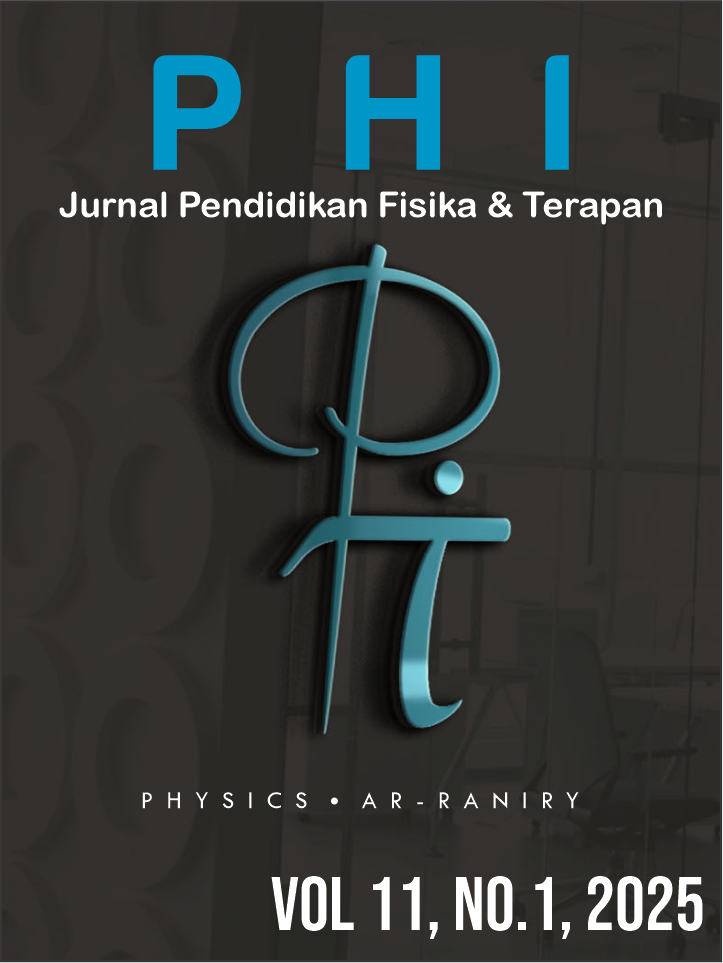Analysis of Students' Ability in Solving Physics Problems on the Concept of Thermodynamics for Class XI SMAN 2 Binongko
DOI:
https://doi.org/10.22373/p-jpft.v11i1.24682Keywords:
Student Ability, Physics Questions, Cognitive Aspects, ThermodynamicsAbstract
The majority of physics learning in high school is still considered difficult to understand and has an impact on low ability to solve the problems given. This research aims to (1) determine students' knowledge abilities in solving physics problems on thermodynamic concepts. (2) Knowing students' understanding abilities in solving physics problems on thermodynamic concepts. (3) Knowing students' application abilities in solving physics problems on thermodynamic concepts. (4) a description of students' analytical abilities in solving physics problems on thermodynamic concepts. This research method uses a quantitative descriptive research design. The subjects in this research were class XI students at SMAN 2 Binongko. The data collection technique used essay test questions which were then given to class XI students. The research results show that (1) Students' ability to solve physics questions at the knowledge level (C1) is categorized as high with a percentage of 44%. (2) Students' ability to solve physics questions at the understanding level (C2) is categorized as moderate with a percentage of 36%. (3) Students' ability to solve physics questions at the applied level (C3) is categorized as very low with a percentage of 64%. (4) Students' ability to solve physics questions at the analysis level (C4) is categorized as very low with a percentage of 75%.References
Ady, W. N. (2022). Analisis Kesulitan Belajar Siswa SMA terhadap Mata Pelajaran Fisika pada Materi Gerak Lurus Beraturan. Jurnal Pendidikan Dan Ilmu Fisika, 2(1). https://doi.org/10.52434/jpif.v2i1.1599
Anderson, L. ., & Krathwohl, D. . (2010). Kerangka Landasan untuk: Pembelajaran, Pengajaran, dan Asesmen. Terjemahan oleh Agung Prihantoro. In Pustaka Pelajar.
Fatimah, Z., Hikmawati, H., & Wahyudi, W. (2019). Pengaruh Model Pembelajaran Generatif dengan Teknik Guided Teaching Terhadap Kemampuan Pemecahan Masalah Fisika Kelas XI. KONSTAN - Jurnal Fisika Dan Pendidikan Fisika, 4(1). https://doi.org/10.20414/konstan.v4i1.25
Fitri, L., Mahzum, E., & Hamid, A. (2022). Efektivitas Penggunaan Aplikasi Quizizz Dalam Evaluasi Pembelajaran Fisika Terhadap Kemampuan Kognitif Siswa. Jurnal Pendidikan Fisika, 11(2). https://doi.org/10.24114/jpf.v11i2.38115
Hafizah, S. (2020). Penggunaan Dan Pengembangan Video Dalam Pembelajaran Fisika. Jurnal Pendidikan Fisika, 8(2). https://doi.org/10.24127/jpf.v8i2.2656
Halmuniati, H., Muhammad Dani Saputra, Nurfaidah Syam, & La Wui. (2022). Analysis of Teacher Difficulties in Teaching Physics Courses in MAN 1 Konawe Selatan. Jurnal Pendidikan Fisika Dan Teknologi, 8(2), 157–162. https://doi.org/10.29303/jpft.v8i2.3843
Handayani, M. W., Swistoro, E., & Risdianto, E. (2018). Pengaruh Model Pembelajaran Problem Solving Fisika terhadap Kemampuan Penguasaan Konsep dan Kemampuan Pemecahan Masalah Siswa Kelas X MIPA SMAN 4 Kota Bengkulu. Jurnal Kumparan Fisika, 1(3). https://doi.org/10.33369/jkf.1.3.36-44
Hardianti, T. (2018). Analisis kemampuan peserta didik pada ranah kognitif dalampembelajaran fisika SMA. Seminar Nasional Quantum, 25.
Johari, S. (2018). Teori Pembelajaran. Psikologi Pendidikan.
Juhanda, A. (2016). Analisis Soal Jenjang Kognitif Taksonomi Bloom Revisi Pada Buku Sekolah Elektronik (Bse) Biologi SMA. Jurnal Pengajaran Matematika Dan Ilmu Pengetahuan Alam, 21(1). https://doi.org/10.18269/jpmipa.v21i1.36258
Kurniawan, H. C., Fatimah, S., & Sari, A. (2023). Analisis Kemampuan Pemecahan Masalah Siswa dalam Menyelesaikan Soal IPA (Fisika) pada Materi Usaha dan Pesawat Sederhana Kelas VIII MTsN 2 Trenggalek. KONSTAN - JURNAL FISIKA DAN PENDIDIKAN FISIKA, 7(02). https://doi.org/10.20414/konstan.v7i02.104
Miftana. (2015). Uji Kemampuan Kognitif MAN 2 Madiun Kelas XI IPA dalam Menyelesaikan Soal Termodinamika.
Muslimin, Hidayat, M. Y., & Anggereni, S. (2018). Analisis Kemampuan Siswa dalam Menyelesaikan Soal Fisika Materi Suhu dan Kalor Berbasis Taksonomi Kognitif Bloom Kelas X di SMAN 3 Sampolawa. Jurnal Pendidikan Fisika, 6(2).
Novisya, D. (2017). Analisis Kemampuan Siswa dalam Penyelesaian Soal-Soal Fisika pada Materi Gerak Parabola. In Universitas Islam Negeri Mahmud Yunus Batusangkar Kabupaten Padang Pariaman”.
Rahayu, D. N. G., Harijanto, A., & Lesmono, A. D. (2018). Tingkat Kemampuan Berpikir Kritis Siswa SMA pada Materi Fluida Dinamis. Jurnal Pembelajaran Fisika, 7(2), 162–167.
Wahyuni, A. . (2022). Literature Review: Pendekatan Berdiferensiasi Dalam Pembelajaran IPA. JURNAL PENDIDIKAN MIPA, 12(2). https://doi.org/10.37630/jpm.v12i2.562
Wardani, K. E. K., Djudin, T., & Mursyid, S. (2021). Pengaruh Model Cooperative Problem Solving Terhadap Kemampuan Pemecahan Masalah Siswa Pada Materi Tekanan. Jurnal Inovasi Penelitian Dan Pembelajaran Fisika, 2(1). https://doi.org/10.26418/jippf.v2i1.42453
Yunus, M. (2021). Analisis Kemampuan Kognitif Siswa Kelas IX Menggunakan Pembelajaran Matematika Sistem Daring Di MTS AL-Mawasir Padang Kalua. IAIN Palopo.
Downloads
Published
Issue
Section
License
Authors who publish with Jurnal Phi agree to the following terms:
- Authors retain copyright and grant the journal right of first publication with the work simultaneously licensed under a Creative Commons Attribution License (CC BY 4.0) that allows others to share the work with an acknowledgment of the work's authorship and initial publication in this journal.
- Authors are able to enter into separate, additional contractual arrangements for the non-exclusive distribution of the journal's published version of the work (e.g., post it to an institutional repository or publish it in a book), with an acknowledgment of its initial publication in this journal.
- Authors are permitted and encouraged to post their work online (e.g., in institutional repositories or on their website) prior to and during the submission process, as it can lead to productive exchanges, as well as earlier and greater citation of published work (See The Effect of Open Access).

















